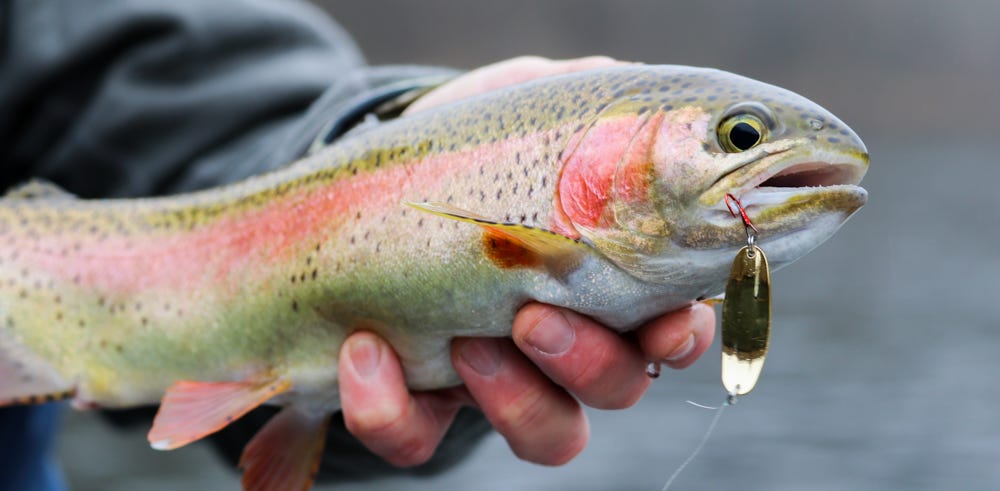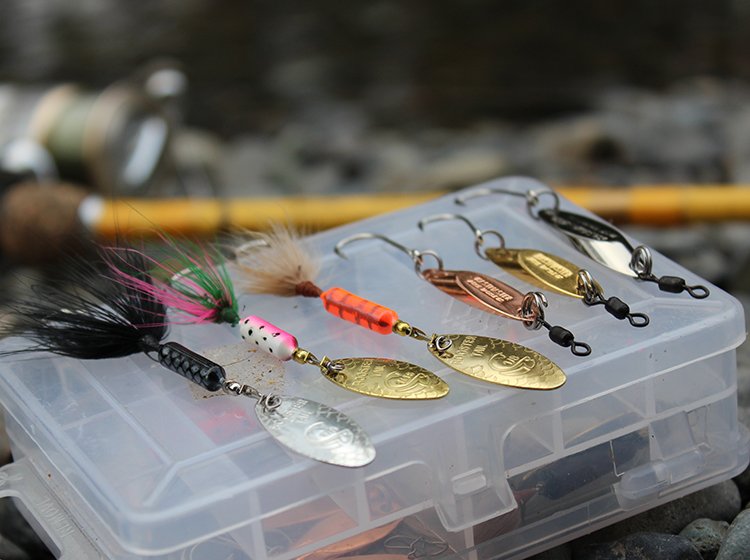The best bait for catching rainbow trout is live bait like worms or artificial lures such as spinners and spoons. These baits effectively mimic the trout’s natural food sources.
Rainbow trout are popular among anglers due to their vibrant colors and spirited fight. Choosing the right bait is crucial to increase your chances of success. Live bait, such as nightcrawlers, mealworms, and minnows, attract trout by imitating their natural prey.
Artificial lures like spinners, spoons, and small crankbaits also work well, especially in clear water where their flash and movement can entice strikes. Understanding the trout’s feeding habits and local environment helps in selecting the most effective bait. With the right approach, you can enjoy a rewarding fishing experience.
Introduction To Rainbow Trout Fishing
Rainbow trout are a favorite among anglers. Their beautiful colors and spirited fight make them exciting to catch. Rainbow trout fishing is fun and rewarding.
To catch them successfully, using the right bait is key. In this post, we’ll explore why rainbow trout are special and the best seasons to fish for them.
Why Rainbow Trout?
Rainbow trout are popular due to their vibrant colors and strong fight. They are found in many rivers, lakes, and streams. They are also stocked in many fishing areas, making them accessible.
Rainbow trout are not only fun to catch but also delicious. They offer a great challenge for both beginners and experienced anglers.
Fishing Seasons
The best time to fish for rainbow trout depends on the location. Here is a simple guide:
| Season | Best Locations | Why |
|---|---|---|
| Spring | Lakes and Rivers | Trout are active after winter. |
| Summer | Mountain Streams | Cooler waters are preferred. |
| Fall | Rivers | Trout prepare for winter. |
| Winter | Tailwaters | Consistent water temperatures. |
Using the best bait and understanding the seasons will increase your chances of success. Happy fishing!
Choosing The Right Bait
Catching rainbow trout can be a fun and rewarding experience. Selecting the right bait is crucial for success. There are many options, each with its own benefits. Understanding these options will help you catch more trout. Let’s explore the best baits for rainbow trout.
Natural Baits
Natural baits are a popular choice for catching rainbow trout. They mimic the trout’s natural food. Here are some effective natural baits:
- Worms: Worms are easy to find and very effective.
- Insects: Grasshoppers, crickets, and beetles work well.
- Salmon Eggs: These are a favorite among trout.
- Minnows: Live minnows attract larger trout.
Using natural baits can increase your chances of a catch. They look and smell like the trout’s natural prey.
Artificial Baits
Artificial baits are another excellent choice. They come in various shapes, sizes, and colors. Here are some popular artificial baits:
- Spinners: These create vibrations and flash in the water.
- Spoons: Their wobbling action mimics injured baitfish.
- Soft Plastics: These can imitate worms, insects, or small fish.
- Crankbaits: These lures mimic the swimming action of fish.
Artificial baits are versatile and reusable. They can be a great addition to your fishing gear.
| Natural Baits | Artificial Baits |
|---|---|
| Worms | Spinners |
| Insects | Spoons |
| Salmon Eggs | Soft Plastics |
| Minnows | Crankbaits |
Choosing the right bait involves understanding the behavior of rainbow trout. Both natural and artificial baits have their advantages. Experiment with different baits to see what works best for you.
Top Natural Baits
Rainbow trout are one of the most sought-after fish. Using natural bait can increase your chances of catching them. Below, we explore the top natural baits for rainbow trout.
Worms
Worms are a classic bait for rainbow trout. They are easy to find and use. You can get them from your garden or a bait shop.
- Nightcrawlers
- Red Wigglers
- Mealworms
Attach the worm to your hook, letting it wiggle in the water. This movement attracts rainbow trout. They see the worm as a tasty meal.
Insects
Insects are another great option for rainbow trout. They are part of the trout’s natural diet.
- Grasshoppers
- Crickets
- Ants
Use a small hook to attach the insect. Cast your line near rocks or weeds where insects gather. Trout often look for food in these areas.
Minnows
Minnows are small fish that rainbow trout love to eat. They are effective bait, especially in larger water bodies.
| Type of Minnow | Best Use |
|---|---|
| Fathead Minnows | Lakes and Ponds |
| Shiners | Rivers and Streams |
Hook the minnow through the back or lips. This keeps it alive and swimming. The motion attracts the rainbow trout.

Credit: www.outdoorcanada.ca
Effective Artificial Baits
Choosing the right bait is crucial for catching rainbow trout. Artificial baits can be incredibly effective. They mimic the trout’s natural prey and attract their attention. Below, we explore some of the best artificial baits for rainbow trout.
Spinners
Spinners are a popular choice for catching rainbow trout. They create vibrations in the water, which mimic small fish or insects. Rooster Tail and Mepps Aglia are excellent options. They are versatile and work well in various water conditions. Use them in streams, lakes, and rivers for the best results.
| Spinner Type | Best Use |
|---|---|
| Rooster Tail | Streams and rivers |
| Mepps Aglia | Lakes and ponds |
Spoons
Spoons are another effective artificial bait. They reflect light and create a fluttering motion. This action attracts rainbow trout. Kastmaster and Little Cleo are highly recommended. They are great for casting long distances. Their weight allows for deep-water fishing as well.
- Kastmaster – Great for deep-water fishing
- Little Cleo – Excellent for casting long distances
Soft Plastics
Soft plastics offer a realistic feel that trout find irresistible. They come in various shapes and colors. Berkley PowerBait and Yum TroutKrilla are top choices. These baits are scented, which increases their effectiveness. Use them on a jig head for the best results.
- Berkley PowerBait – Scented and highly effective
- Yum TroutKrilla – Realistic feel and various colors
Techniques For Using Bait
Rainbow Trout can be tricky to catch. Knowing the right techniques for using bait can make a huge difference. Here, we’ll discuss three popular methods: Drift Fishing, Bottom Fishing, and Float Fishing.
Drift Fishing
Drift Fishing involves allowing your bait to float naturally with the current. This technique mimics the natural movement of food in the water.
- Select the Right Bait: Use worms, minnows, or artificial lures.
- Use a Light Line: A lighter line makes the bait appear more natural.
- Cast Upstream: Let the current carry your bait downstream.
Adjust the weight to keep the bait near the bottom. This helps attract Rainbow Trout.
Bottom Fishing
Bottom Fishing is effective in deeper waters. It involves placing your bait at the bottom where Rainbow Trout often feed.
| Step | Action |
|---|---|
| 1. | Attach a weight to your line. |
| 2. | Use worms, PowerBait, or salmon eggs. |
| 3. | Cast your line and let it sink. |
Wait for the bite and keep the line tight.
Float Fishing
Float Fishing uses a bobber to keep your bait suspended in the water. This technique is ideal for fishing in shallower waters.
- Choose the Right Float: Use a small, sensitive bobber.
- Select Your Bait: Opt for worms, insects, or small fish.
- Adjust the Depth: Set the bobber so the bait stays mid-water.
Watch the bobber closely. A sudden movement signals a bite.

Credit: www.lurenet.com
Best Locations For Rainbow Trout
Rainbow trout are a popular catch among anglers. Knowing the best locations to find them increases your success. Different habitats offer unique advantages. Below are some of the top spots to find rainbow trout.
Rivers And Streams
Rivers and streams are excellent for catching rainbow trout. These fish love the flowing water and cooler temperatures. Look for them in areas with plenty of cover.
- Deep Pools: Rainbow trout often stay in deep pools. The water is cooler and offers more oxygen.
- Riffles: These are shallow areas with fast-moving water. Trout feed here because the water brings food.
- Undercut Banks: These spots provide shade and protection. Trout feel safe here from predators.
Lakes And Ponds
Lakes and ponds also house rainbow trout. These bodies of water provide different challenges and rewards. Look for trout in specific areas within lakes and ponds.
- Drop-offs: These are areas where the water depth changes. Trout like to stay near drop-offs for safety.
- Weed Beds: These provide food and cover. Trout hunt for insects around weed beds.
- Inlets and Outlets: These are spots where water flows in and out. Trout gather here for the oxygen-rich water.
| Location | Best Time |
|---|---|
| Rivers and Streams | Early Morning |
| Lakes and Ponds | Late Afternoon |
Tips For Maximizing Success
Catching rainbow trout can be a thrilling experience. To increase your chances, you need to know the best tips. These tips can help you succeed in your fishing adventure. Focus on the time of day, water conditions, and weather impact.
Time Of Day
The time of day greatly influences rainbow trout activity. Early morning and late afternoon are the best times. During these periods, the trout are more active and likely to bite. Use this table to plan your fishing times:
| Time | Activity Level |
|---|---|
| Early Morning | High |
| Midday | Low |
| Late Afternoon | High |
Water Conditions
Water conditions play a crucial role in trout fishing. Clear water allows trout to see the bait easily. In murky water, use brightly colored bait. This helps attract the fish. Monitor the water temperature too. Rainbow trout prefer water between 50°F and 60°F.
- Clear water: Use natural-colored bait.
- Murky water: Use brightly colored bait.
- Optimal temperature: 50°F to 60°F.
Weather Impact
Weather conditions can either help or hinder your fishing efforts. Overcast days are ideal for fishing. Rainbow trout are more active on these days. Avoid fishing on very sunny days. The fish tend to hide and are less active. Light rain can also boost your chances. It increases oxygen in the water and makes the fish more active.
- Overcast days: High activity levels.
- Sunny days: Low activity levels.
- Light rain: Increased fish activity.
Seasonal Bait Adjustments
Fishing for rainbow trout requires understanding their feeding habits. These habits change with the seasons. Adapting your bait to these changes can improve your success.
Spring And Summer
In spring, rainbow trout are more active. They search for food that mimics insects and small fish. Effective baits include:
- Worms: These are a natural option and easy to find.
- Insect Larvae: Use them to mimic hatching insects.
- Small Minnows: These attract larger trout looking for bigger meals.
During summer, rainbow trout seek cooler water. Early mornings and late evenings are best for fishing. Use baits like:
- PowerBait: This bait works well in warmer waters.
- Crickets: Rainbow trout find them irresistible.
- Spoons: Their reflective surface attracts fish.
Fall And Winter
In fall, trout prepare for winter by feeding heavily. They prefer high-protein baits. Effective options include:
- Salmon Eggs: These provide a rich source of nutrients.
- Nightcrawlers: These are larger and more enticing.
- Spinners: Their movement mimics injured fish.
During winter, trout are less active but still feed occasionally. Use baits that require minimal movement, such as:
- Jigs: These work well in cold waters.
- Wax Worms: These can entice slow-moving trout.
- Artificial Nymphs: These mimic underwater insects.
Adjusting your bait according to the season can lead to more successful fishing trips. Understanding the trout’s behavior is key.
Advanced Techniques
Fishing for rainbow trout can be an exhilarating experience. Utilizing advanced techniques can significantly increase your success rate. This section explores the best methods for catching these vibrant fish using two sophisticated techniques: Fly Fishing and Trolling.
Fly Fishing
Fly fishing is an art that requires patience and skill. It involves using lightweight lures called flies, which mimic the insects that trout feed on. The key to success in fly fishing is selecting the right fly.
- Dry Flies: These float on the water surface and are effective during hatching seasons.
- Wet Flies: These sink below the surface, imitating drowned insects.
- Nymphs: These resemble immature insects and are ideal for deeper waters.
Another important aspect is mastering the casting technique. Proper casting ensures the fly lands softly on the water, mimicking a natural insect landing.
Consider using a 9-foot rod with a 5-weight line for optimal performance. Always observe the water and match your flies to the local insect population.
Trolling
Trolling involves dragging lures behind a moving boat. This technique covers a large area and targets trout at various depths. The choice of lure and speed are crucial factors.
| Lure Type | Best Use |
|---|---|
| Spoons | Effective for their wobbling action, ideal for deeper waters. |
| Crankbaits | Designed to dive to specific depths, mimicking baitfish. |
| Spinners | Produce vibrations that attract trout, best for shallow waters. |
Adjust your trolling speed to between 1.5 to 2.5 mph for the best results. Use a fish finder to locate schools of trout and adjust your depth accordingly.
Using downriggers can help maintain the desired lure depth. Experiment with different lures and speeds to find what works best in your fishing location.

Credit: fishingbooker.com
Frequently Asked Questions
What Is The Best Bait For Rainbow Trout?
The best bait for rainbow trout includes worms, minnows, and artificial lures. PowerBait and corn also work well.
How Do You Fish For Rainbow Trout?
To fish for rainbow trout, use light tackle and small hooks. Cast near structures and retrieve slowly.
Can You Catch Rainbow Trout With Flies?
Yes, fly fishing is effective for rainbow trout. Use dry flies, nymphs, and streamers for best results.
What Time Is Best For Catching Rainbow Trout?
Early morning and late afternoon are ideal times for catching rainbow trout. They are more active during these periods.
Conclusion
Choosing the best bait for catching rainbow trout can enhance your fishing experience. Experiment with various options like worms, minnows, and artificial lures. Understanding what works best in your local waters can lead to more successful catches. Happy fishing, and may your next trip be fruitful with rainbow trout!

